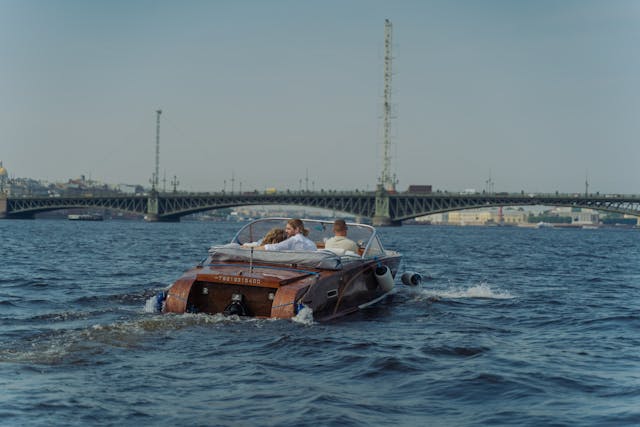Discover the power and passion behind a 305 marine cammed supercharged boat launch: torque, roar, and reflection meet water.
A 305 marine cammed supercharged boat launch refers to testing or debuting a boat powered by a 305 engine fitted with a custom camshaft and supercharger, delivering raw torque, boosted RPMs, and explosive water performance. Like innovative business model innovations, custom marine engineering requires strategic planning and creative problem-solving.
It started like most bad ideas do: with a wrench, a late-night forum post, and an ego that whispered, Why not a 305?
I had spent years watching big-block braggers with their 454s and LS-swapped monsters tear up the marina, while my old 305 sat in the corner, gathering dust and resentment. But something about the underdog always gets me. That small-block Chevy, cammed and supercharged, felt like a secret waiting to explode.
The morning of the boat launch, the sky was steel-gray, wind low, and my hands were shaking with caffeine and fear. It wasn’t just about horsepower anymore. It was about whether the gamble, the sleepless nights, the re-torqued bolts, and the belt squeal that haunted my sleep would finally pay off when metal met water.
Article Breakdown
What a 305 Marine Cammed Supercharged Setup Really Means
Let’s break it down before we go full throttle.
A 305 marine engine is a small-block V8 known for being compact, lighter, and somewhat underpowered compared to its 350 or 454 cousins. But that doesn’t mean it’s weak. With the right camshaft and a marine-rated supercharger, it transforms from “decent” to “detonator.”
The Cam, the Heartbeat of the Beast
The camshaft defines how your engine breathes. A cammed 305 means it’s fitted with an aftermarket cam profile, usually more aggressive than stock, to open valves longer and deeper for better air-fuel mix and exhaust flow.
Think of it like teaching your engine to breathe fire instead of air. That loping idle, that uneven heartbeat? That’s music made from math.
In marine setups, the cam profile has to balance torque delivery, for pulling the hull through water, with high-RPM breathing for top-end speed. Too aggressive, and you lose low-end grunt. Too mild, and you choke your supercharger’s potential.
The Supercharger, Controlled Chaos on Demand
Then comes the supercharger, the mechanical lung that forces more air into each cylinder. Boost is beautiful because it’s instant, no waiting for RPM magic.
A marine-rated supercharger, often a centrifugal or roots-style unit, adds 30 to 50 percent more power depending on pulley ratio and boost level. Mine? A modest 8 PSI setup that felt anything but modest when it screamed to life.
When you combine a cammed 305 with boost, the torque curve doesn’t just rise, it punches you in the chest and dares you to hold on.
The Build Journey, From Idea to Water-Ready Monster
The First Bolt That Started It All
Every build has a click moment, that first bolt you undo where you realize there’s no going back. Mine came on a cold evening, pulling the stock intake off the 305, the smell of old gasket sealer cutting through the air.
I told myself, If this blows up, at least it’ll be a loud failure.
I sourced an Edelbrock marine intake, a Comp Cams 270 marine cam, and a ProCharger M1 setup designed for small-block marine engines. It wasn’t cheap. It wasn’t smart. But every time I imagined the prop slicing water under boost, logic felt irrelevant.
Tuning, Testing, and Tiny Disasters
Marine tuning is an art form. You’re fighting humidity, temperature shifts, and the merciless feedback of water resistance.
At 3,500 RPM, the boat’s load feels like a car pulling a trailer uphill forever. So, every tune tweak mattered.
Fuel maps, timing curves, all had to be perfect. I spent nights hunched over a laptop, chasing smoother acceleration and safe air-fuel ratios. One wrong click, and detonation turns your pistons into aluminum confetti.
The Launch Prep
The night before launch, I walked around the boat like it was alive, tightening clamps, checking oil lines, rerouting vacuum hoses. You learn things about yourself in those hours: how patient you really are, how much you trust your own hands.
By sunrise, she sat on the trailer, gleaming. Not perfect, but mine.
The Boat Launch, Where Theory Meets Water
The ramp was quiet. A mist hung over the lake. My chest felt tighter than any torque wrench I’d owned.
I turned the key.
The 305 barked to life, that cammed idle hitting like a syncopated drumline. Each pulse echoed off the dock. Heads turned. I swear I saw one old-timer mouth, That’s not stock.
Throttle, Boost, and Awe
Easing her into gear, the hull shivered. Then I pushed the throttle forward.
The supercharger whined like a banshee. Boost built fast, too fast, and the bow lifted, slicing clean through the water. It wasn’t violent. It was spiritual.
Somewhere between 4,000 and 5,000 RPM, the whole lake disappeared. It was just sound and spray and a feeling like gravity had given up.
You don’t measure joy in speed; you measure it in goosebumps.
The Numbers That Tell the Story
| Component | Specification | Performance Impact |
|---|---|---|
| Engine | Chevy 305 Marine Block | Lightweight, compact V8 base |
| Camshaft | Comp Cams 270 Marine | Increases torque and throttle response |
| Supercharger | ProCharger M1 @ 8 PSI | 45% power gain, instant boost |
| Fuel System | Holley Marine EFI | Consistent delivery under load |
| Max RPM | 6,200 | Broad, usable range |
| Launch Speed | 0–30 knots in 5.4s | Instant mid-range thrust |
| Estimated HP | 400+ HP | From a 305, yes, really |
What Makes the 305 Marine Cammed Supercharged Setup Unique
The Underdog Engine That Shouldn’t Work This Well
The 305 is often dismissed as “just okay.” It’s the younger sibling of the legendary 350, and in stock form, that reputation fits. But when you build it right, balance it, blueprint it, and add boost, it becomes proof that you don’t need displacement to demand respect.
Boost and Water Don’t Forgive Mistakes
The combination of supercharging and marine environment introduces risk most people underestimate. Salt, moisture, and heat can destroy seals and bearings fast. That’s why every fitting, hose, and gasket must be marine-rated, or you’ll be fishing for engine parts by next week.
Soundtrack of Satisfaction
People talk about horsepower. But what they really chase is sound.
That chopped idle turning into a rising wail under boost is addictive. The dock became my stage, and the 305’s voice became the encore.
Lessons Learned from the Launch
I learned that perfection isn’t real; it’s just torque wrapped in hope.
I learned that when a boat hooks under power, it feels like physics took a day off.
And most of all, I learned that the satisfaction of hearing your custom build come alive is more addictive than the speed itself.
Comparing the 305 Supercharged Setup to Larger Builds
| Engine | Displacement | Average HP (Marine Build) | Weight | Sound Profile | Launch Feel |
|---|---|---|---|---|---|
| 305 (Cammed + Supercharged) | 5.0L | 380–420 HP | Light | High-pitched roar | Snappy, quick |
| 350 (Naturally Aspirated) | 5.7L | 330–370 HP | Medium | Deep growl | Smooth, strong |
| 454 Big Block | 7.4L | 500–600 HP | Heavy | Throaty thunder | Brutal but slower revs |
The takeaway is simple: the 305 marine cammed supercharged setup doesn’t win on paper, it wins in personality. It’s not the loudest, nor the biggest, but it’s alive in a way few engines are.
Frequently Asked Questions
What is a 305 marine cammed supercharged boat? It’s a performance-modified marine vessel using a 305 engine equipped with an aftermarket camshaft and supercharger for boosted power.
How much horsepower does a supercharged 305 marine engine make? Depending on boost levels and tuning, it can reach between 380 and 420 horsepower.
Is supercharging a marine engine safe? Yes, as long as you use marine-rated parts and conservative tuning. Moisture control and reliable fuel delivery are essential.
What kind of cam is best for a 305 marine engine? A moderate lift, wide LSA cam, around 112 to 114 degrees, that maintains low-end torque while supporting boosted airflow.
Can a 305 marine engine outperform a 350? With boost and proper tuning, it can match or even exceed a naturally aspirated 350, especially in lighter hulls.
Key Takings
- A 305 marine cammed supercharged boat launch proves creativity beats displacement.
- The combination of cam and boost turns an underdog engine into a performance masterpiece.
- Proper marine tuning is critical because water never forgives mistakes.
- The emotional payoff of launching a custom build is priceless.
- Horsepower is measured in numbers, but satisfaction is measured in sound.
- Even small-block builds can deliver big-block feelings with the right setup.
- Every launch is both a test of engineering and of heart.
Additional Resources
- ProCharger Marine Systems Guide: Detailed overview of marine-rated supercharger systems and their installation requirements.
- Comp Cams Marine Performance Profiles: Find camshaft profiles optimized for marine torque curves and boosted engine setups.



